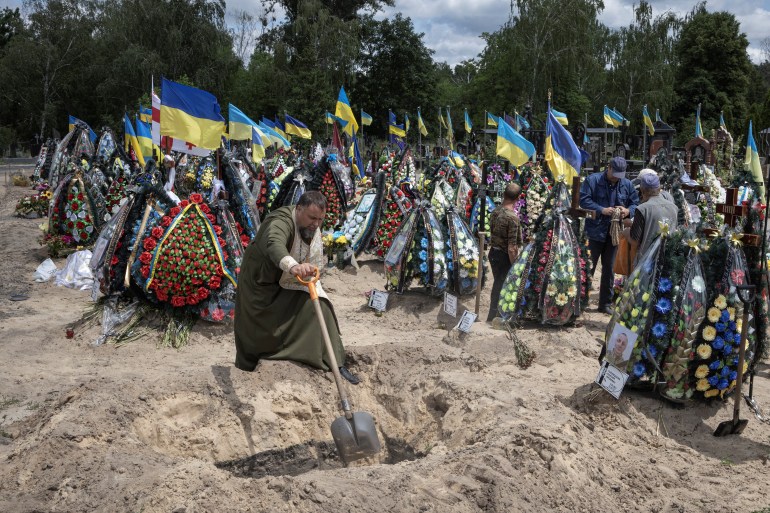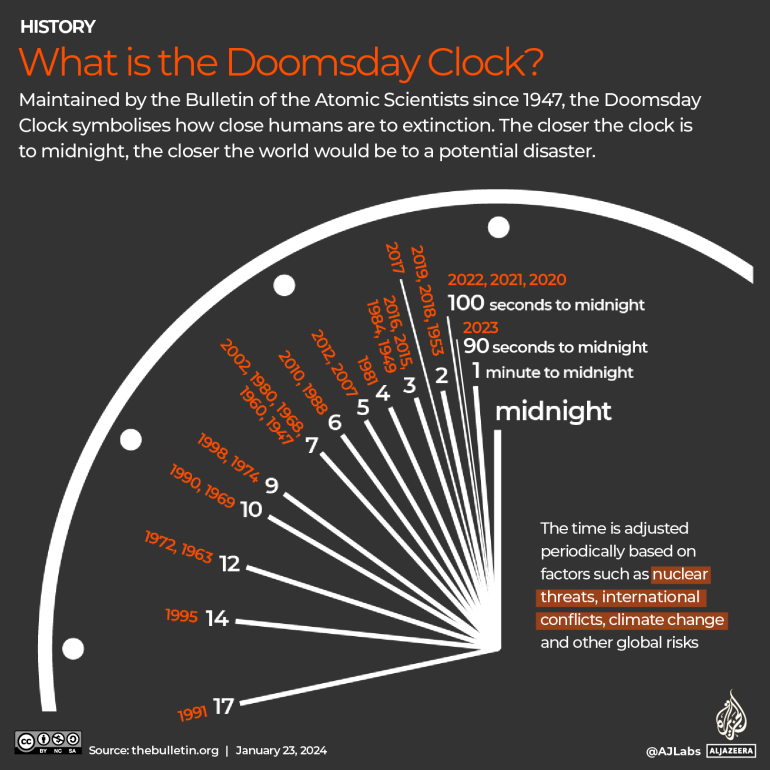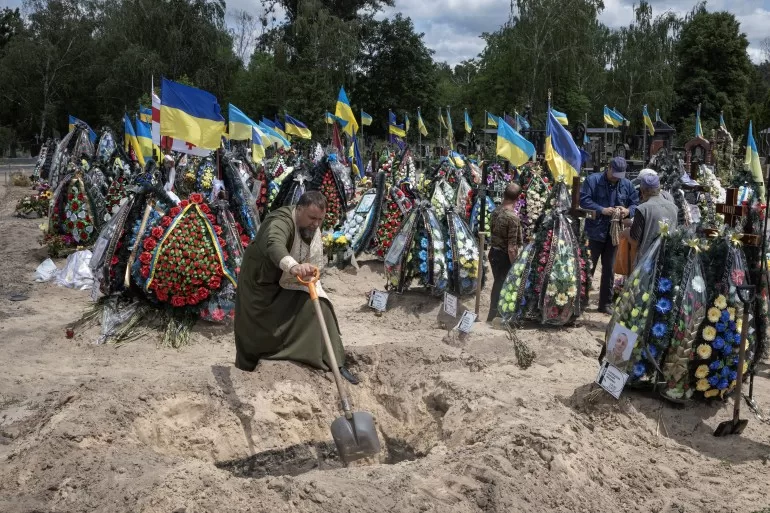Here is what we know about the Doomsday Clock and Tuesday’s announcement:
What did the Bulletin of the Atomic Scientists announce?
Scientists kept their Doomsday Clock close to midnight and the latest it’s ever been set in its 77-year history.
“Conflict hot spots around the world carry the threat of nuclear escalation, climate change is already causing death and destruction, and disruptive technologies like AI and biological research advance faster than their safeguards,” Rachel Bronson, the bulletin’s president and CEO, said, adding that keeping the hands of the clock unchanged from the prior year is “not an indication that the world is stable”.
What war and conflicts led to this announcement?
Russia’s large-scale invasion of Ukraine, set to reach its second anniversary next month, has escalated tensions with the West to their most dangerous levels since the Cold War.
“A durable end to Russia’s war in Ukraine seems distant, and the use of nuclear weapons by Russia in that conflict remains a serious possibility. In the past year, Russia has sent numerous worrying nuclear signals,” Bronson said.
Bronson cited Russian President Vladimir Putin’s decision in February to suspend Russian participation in the New START treaty with the United States, which limited the strategic nuclear arsenals of the two countries.
The US and Russia between them have nearly 90 percent of the world’s nuclear warheads, enough to destroy the planet many times over.
Bronson additionally cited Putin’s March announcement of Russia’s deployment of tactical nuclear weapons in Belarus and the Russian parliament’s October passage of a law withdrawing ratification of the global treaty banning nuclear weapons tests.

Israel has been at war with Hamas since the Palestinian group, based in Gaza, launched attacks in southern Israel on October 7.
“As a nuclear state, Israel’s actions are clearly relevant to the Doomsday Clock discussion. Of particular worry is that the conflict might escalate more broadly in the region, creating a larger conventional war and drawing in more nuclear powers or near-nuclear powers,” Bronson said.
Climate change was also considered.
“The world in 2023 entered into uncharted territory as it suffered its hottest year on record, and global greenhouse gas emissions continued to rise,” Bronson added.
“Both global and North Atlantic sea-surface temperatures broke records, and Antarctic sea ice reached its lowest daily extent since the advent of satellite data.”
Bronson said 2023 also was a record-breaking year for clean energy with $1.7 trillion in new investments. Offsetting this, however, were fossil fuel investments of nearly $1 trillion, Bronson said.
Her organisation also warned about artificial intelligence.
“AI-enabled disinformation efforts could be a factor that prevents the world from dealing effectively with nuclear risks, pandemics, and climate change,” a press release added.

What is the Doomsday Clock?
The Doomsday Clock is a symbolic timepiece showing how close we are to “destroying our world with dangerous technologies of our own making”, according to the bulletin, a Chicago-based nonprofit organisation that controls the clock.
The bulletin describes it as “many things all at once: It’s a metaphor, it’s a logo, it’s a brand, and it’s one of the most recognisable symbols in the past 100 years.”
The closer it moves to midnight, the closer humanity is to the end of the world.
Apocalyptic threats could arise from political tensions, weapons, technology, climate change or pandemics.
How is the clock set?
The hands of the clock are moved closer to or farther away from midnight based on the scientists’ reading of existential threats at a particular time.
The bulletin updates the time annually. A board of scientists and other experts in nuclear technology and climate science, including 10 Nobel laureates, discuss world events and determine where to place the hands of the clock each year.
“The Bulletin is a bit like a doctor making a diagnosis,” the organisation said on its website.
“We look at data, as physicians look at lab tests and x-rays, and also take harder-to-quantify factors into account, as physicians do when talking with patients and family members. We consider as many symptoms, measurements, and circumstances as we can. Then we come to a judgment that sums up what could happen if leaders and citizens don’t take action to treat the conditions,” it added.
Today, the Bulletin’s Science and Security Board once again sets the #DoomsdayClock at 90 seconds to midnight.
Humanity continues to face an unprecedented level of danger.
Read the full statement: https://t.co/PowB7RkzXw pic.twitter.com/aRyF2ZX3wB
— Bulletin of the Atomic Scientists (@BulletinAtomic) January 23, 2024
Can we still turn the clock back?
According to the bulletin, it’s possible, and it has happened before.
But for it to happen, the bulletin recommends that “three of the world’s leading powers – the US, China and Russia” start a serious dialogue.
“They have the capacity to pull the world back from the brink of catastrophe. They should do so, with clarity and courage, and without delay,” the statement said.
When was the Doomsday Clock created?
The clock was created in 1947 by the Bulletin, which was founded two years earlier by scientists Albert Einstein, J Robert Oppenheimer and Eugene Rabinowitch along with University of Chicago scholars.
During that time, the clock was set at seven minutes to midnight, but after the Soviet Union successfully tested its first atomic bomb in 1949, Rabinowitch, who was then the bulletin’s editor, moved the clock to three minutes to midnight.
The farthest the clock has been from midnight was 17 minutes. That was in 1991 when US President George HW Bush and Soviet leader Mikhail Gorbachev signed the Strategic Arms Reduction Treaty (START) to reduce the number of their countries’ nuclear weapons and ballistic missiles.
According to the University of Chicago, until recently, the closest it had ever been set was at two minutes to midnight: in 1953 when the US and the Soviet Union tested thermonuclear weapons and in 2018 because of “a breakdown in the international order, of nuclear actors, as well as the continuing lack of action on climate change”.
Then, in 2023, the clock moved its closest to midnight – just 90 seconds away. The organisation said the update was made “largely (though not exclusively) because of the mounting dangers of the war in Ukraine”.
“The possibilities that the conflict could spin out of anyone’s control remains high,” Bronson said.
The Doomsday Clock is placed in the bulletin offices at the University of Chicago.
The 2024 #DoomsdayClock announcement is this upcoming Tuesday, January 23.
This issue of the Bulletin’s magazine is devoted to answering the common question of what we can do to #TurnBackTheClock and help reduce major global threats.
Read the intro: https://t.co/de24fqtZf9 pic.twitter.com/HcpYv6SCgh
— Bulletin of the Atomic Scientists (@BulletinAtomic) January 21, 2024
